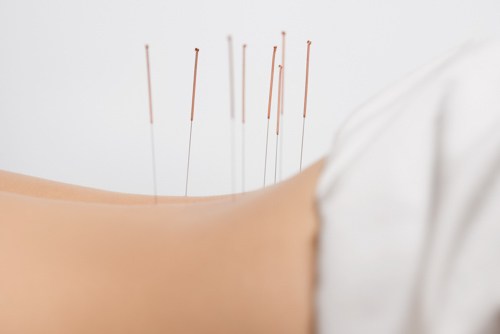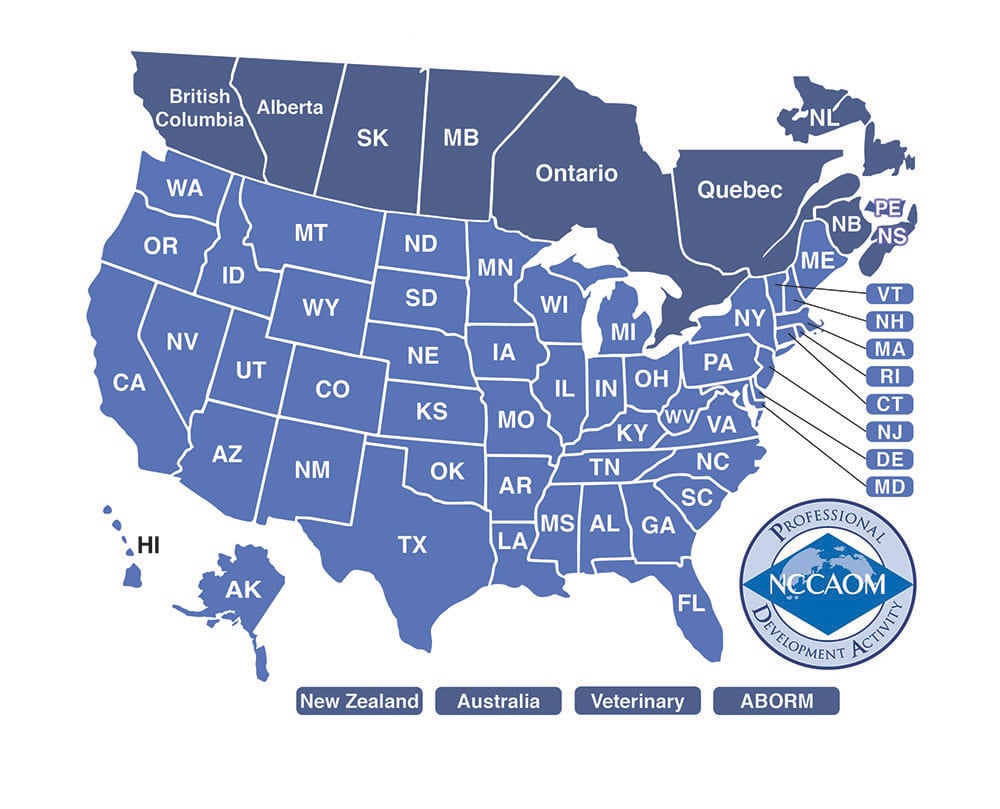PID and Chinese Medicine, Part 1
Course Sample

Example from the Western Medicine Section
Definition
Pelvic Inflammatory Disease (PID) is the inflammation of the female pelvic organs and/or connective tissues usually caused by an infection. The infection may involve a single organism or may be polymicrobial. PID includes disorders such as cervicitis (cervical inflammation), endometritis (uterine inflammation), salpingitis (fallopian tube inflammation), oophoritis (ovarian inflammation), and inflammation or infection of either or both of the broad ligaments (lateral ligaments composed of peritoneum passing from the sides of the uterus to the walls of the pelvis). General symptoms are abdominal pain and vaginal discharge. Physical exam is notable for cervical motion tenderness.
Acute PID
Acute PID symptoms include lower abdominal pain often with rebound pain, fever, cervical motion tenderness, lower abdominal tenderness upon palpation, leukorrhea marked by copious purulent discharge, and nausea. An elevated white blood cell and neutrophil count is usually present. Abscesses may develop in the acute or subacute stages that are commonly treated with antibiotics or surgical procedures to drain or remove the affected areas. General peritonitis may occur due to the spread of exudate to the pelvic perineum. This may be accompanied by nausea and vomiting. In severe cases, endotoxemia and shock may occur.
Acute PID presenting with a palpable pelvic mass indicates a possible tubo-ovarian abscess (TOA) or hydrosalpinx (the accumulation of serous fluid in the fallopian tube). Approximately 20-30% of cases of PID with tubo-ovarian abscesses are afebrile and many of these cases present with a normal white blood cell count thus making TOA’s difficult to diagnose. Diagnosis for these complications using laparoscopy (an operation using a laparoscope) is widely considered definitive and ultrasonography is also employed. Surgery is required in the case of a ruptured abscess to prevent septic shock.
Chronic PID
Chronic PID symptoms include chronic lower abdominal pain or distention and tenderness upon palpation, leukorrhea, painful intercourse, menstrual irregularities including dysmenorrhea and prolonged menstrual bleeding, sterility, and lower abdominal masses. Lumbosacral pain exacerbated by the menstrual period or sexual intercourse is present is some cases.
Etiology
PID is often the result of an ascending intravaginal infection transmitted by intercourse or an IUD (intrauterine device). IUD related PID is often unilateral. PID may also occur after childbirth (puerperal fever), vaginal surgery, or an abortion. Gonorrhoeae and chlamydia commonly cause PID but other microorganisms may be responsible: many types of bacteria, viruses, mycoplasmas (parasitic microorganisms of genus Mycoplasma). Other causes of PID include tuberculosis, actinomycosis, schistosomiasis, leprosy, oxyuriasis, and sarcoidosis.
Differentiation of Acute PID from Acute Appendicitis and Ectopic Pregnancy
Acute PID often mimics acute appendicitis and ectopic pregnancy. Cultures and smear from the cervical, urethral, and rectal areas may help in identifying the microorganisms associated with PID. Appendicitis is often differentiated by initial pain around the umbilicus or upper abdomen then moving to the lower right abdomen with accompanying vomiting, nausea, or other digestive symptoms. Rebound pain at McBurney’s point (a point on the abdominal wall that lies between the navel and the right anterior superior iliac spine) is often present with acute appendicitis and helps to differentiate it from PID. Ectopic pregnancy is differentiated by a positive pregnancy test, irregular vaginal bleeding, and violent pain of the lower abdomen that usually starts on one side but may spread to the other as well. Hospitalization is required for these surgical emergencies.
PID Facts
In the United States, the PID rate is highest in sexually active women under the age of 25. PID can lead to the destruction of tissue that can result in sterility. PID may cause scarring of the reproductive organs, especially the fallopian tubes, which can lead to ectopic pregnancy. The Centers for Disease Control and Prevention (CDC) notes that in the U.S.A. annually more than 1 million women experience an episode of PID, over 100,000 women become infertile as a result, and more than 150 women die from PID or its complications. The CDC notes that a large proportion of ectopic pregnancies are due to PID related complications. The CDC also notes that while lower abdominal pain and other symptoms are common, chlamydial infection related PID can be asymptomatic.
Example from the Theory Section
Overview
In Traditional Chinese Medicine (TCM), Pelvic Inflammatory Disease is categorized under several classifications including dysmenorrhea, leukorrhea, menorrhagia (abnormally heavy bleeding at menstruation), infertility, and palpable masses. PID is the inflammation of one or more of the following: cervix, uterus, fallopian tubes, ovaries, broad ligaments, peritoneum and connective tissues of the pelvic cavity. In some cases, PID involves the scarring of internal tissues which may lead to infertility.
Lower abdominal pain and vaginal discharge (leukorrhea) are the predominant symptoms. PID is the invasion of Damp-Heat and Toxins causing Qi and Blood Stagnation in the Lower Burner. The acute stage is characterized by Heat more than Damp and the chronic stage is characterized by Damp more than Heat combined with Qi and Blood Stagnation. Chronic stage PID often combines with Qi and Yin Deficiency. For the treatment of chronic PID, general treatment principles are often a combination of Clearing Heat and Toxins and Damp-Heat lingering from the acute stage combined with treating the sequelae: Regulate Qi, Expel Dampness, Warm the Channels, Transform Phlegm, Expel Stagnation.
Leukorrhea
Red, Yellow, or White Belt leukorrhea are present when there is disruption of the Dai (Girdle), Chong (Penetrating), and Ren (Conception) Channels due to Damp-Heat in the Lower Burner or Qi and Blood Deficiency. White Belt leukorrhea is characterized by white or clear vaginal discharge without odor and involves Spleen Qi and/or Kidney Yang deficiency with Excess Dampness. Yellow Belt leukorrhea is characterized by yellow vaginal discharge that has a foul odor and involves Spleen Damp-Heat or Liver & Gallbladder Damp-Heat. Red Belt leukorrhea is characterized by the presence of blood in the vaginal discharge and involves Heat in the Blood and/or Liver Heat changing into Fire.
Important Factors of Susceptibility to PID
- Sexual Transmitted Diseases (STD’s), especially gonorrhea and chlamydia
- Uterine foreign object (IUD typically starts with unilateral pain)
- Sexual intercourse one day prior to or during menstruation
- Surgery in the pelvic cavity
- Abortion, especially multiple abortions
- Postpartum
- Miscarriage, especially chronic miscarriages
- Nearby organ (urination bladder, large intestine) transfers infection, especially appendicitis transfers infection
- Following the very first time of sexual intercourse
Acute Stage PID Overview
Pulse: Slippery, rapid Tongue: Red body with thick, yellow coat
Diagnoses Classifications
I Damp-Heat and Toxins in the Lower Burner
II 4 Levels differentiation: Qi Level Heat that may progress to the Ying Level
III 6 Stages differentiation: Yangming Stage illness that may progress to the Tai Yin Stage
Indications
Severe or rebound lower abdominal pain, Red or Yellow Belt leukorrhea, fever, chills, diarrhea or constipation, Urine: burning sensation, yellow color
In some cases: pyogenic (pus producing) abdominal mass that may be palpable
Treatment Principle: Clear Heat and Toxins, Clear Lower Burner Damp-Heat
Note: Acute PID takes the form of an acute infection in the Lower Burner (Jiao). In severe cases, a surgical emergency may develop. Surgical emergencies are not treated in the TCM clinic and require hospitalization. Acupuncture and herbal medicine treatment for acute PID in addition to an antibiotic regime increases clinical efficacy and helps to prevent subacute flare-ups and chronic PID. In some cases, the acute stage is not diagnosed or treated and quickly and transforms into the chronic stage within several days.
Example from the Acupuncture Section
Acute PID Acupuncture Points
- CV4
- Cv3
- Zi Gong
- GB27
- GB28
- Sp6
- Sp10
- LI11
- LI4
- St36
- St40
- Liv5
- Liv3
Discussion of Point Selection
GB27 and GB28 are both Meeting Points of the Gallbladder (Foot Shaoyang) channel with the Dai (Belt, Girdle) channel. They regulate the Dai channel & lower burner and treat leukorrhea, lower abdominal pain, back pain, and irregular menstruation.
Cv3 and Cv4 are Meeting Points of the Conception (Ren) channel with the Spleen, Liver, and Kidney channels. They benefit the uterus and lower burner. Cv3 regulates Qi, drains damp-heat, and treats leukorrhea.
Zi Gong benefits the uterus, regulates Qi, stops pain, regulates menstruation, and stops uterine bleeding.
Sp6 and Sp10 regulate menstruation, invigorate blood, and treat leukorrhea. Alternately, Sp8 is a Xi Cleft Point which Regulates the Uterus and Harmonizes the Blood and is effective in treating dysmenorrhea with excess bleeding, irregular menstruation, and abdominal pain.
LI4 and LI11 are commonly combined to clear heat, expel wind, and stop pain. LI11 cools the blood, drains damp-heat, regulates Qi and Blood, and treats high fever.
St36 is a Command point for the treatment of abdominal disorders, clears Yangming level heat, and treats nausea, vomiting, and abdominal pain. There is a modern conception that St36 should not be used in combination with external pernicious influences, however, St36 is excellent for clearing heat in combination with reducing (sedating) needle techniques and is classically indicated for use during febrile diseases and for Stomach excess heat. St40 is the Luo (Connecting) point of the Stomach channel and transforms phlegm dampness.
Liv3 is the Source (Yuan) point of the Liver channel and Liv5 is the Connecting (Luo) point of the Liver channel. They regulate Qi & the menses and benefit the lower burner. Liv5 clears damp-heat in the lower burner. Liv3 treats leukorrhea and lower back pain referring to the abdomen. Together, LI4 and Liv3 open the Four Gates and stop pain......
Example from the Herb Section
FORMULA 1
Modified Da Huang Mu Dan Tang “Modified Rhubarb and Moutan Decoction”
Pulse: Rapid, slippery or wiry Tongue: Red body, yellow and greasy coating
Diagnosis
Damp-Heat in the Lower Burner, Qi Stagnation and Blood Stasis in the Lower Burner
Indications
Lower abdominal pain that is worse upon pressure, Yellow Belt leukorrhea, fever, chills
Treatment Principle
Clear Heat, Eliminate Toxins, Break Blood Stasis, Drain Dampness, Reduce Swelling
Ingredients
- Da Huang (Radix et Rhizoma Rhei) 9 grams
- Mu Dan Pi (Cortex Moutan Radicis) 6
- Tao Ren (Semen Persica) 6
- Bai Jiang Cao (Herba cum Radice Patriniae) 9
- Jin Yin Hua (Flos Lonicerae) 9
- Lian Cao (Fructus Forsythiae) 9
- Chi Shao (Yao) (Radix Paeoniae Rubrae) 6
- Yi Yi Ren (Semen Coicis) 9
- Hong Teng (Caulis Sargentodoxae) 9
- (Shan) Zhi Zi (Fructus Gardeniae) 6
- Yan Hu Suo (Rhizoma Corydalis Yanhusuo) 6
- Chuan Lian Zi (Fructus Meliae Toosendan) 6
Dose: 1 bag per day Ratio: Decocted in 3:1 cups of water
Note: This formula is especially effective for acute fallopian tube infection (salpingitis). In some cases, acute salpingitis symptoms may be mild or unrecognized and therefore becomes chronic due to lack of treatment. The acute stage tends to last 2-3 days and quickly progresses to the chronic stage. A key diagnostic indicator for this formula is if the patient had sexual intercourse one day prior to or during her menstrual cycle followed by abdominal pain, fever, and chills 72 hours later. Another key indicator is if this same pattern occurs following the very first sexual intercourse experience.
The base formula of Da Huang Mu Dan Teng is comprised of Da Huang (Radix et Rhizoma Rhei), Mu Dan Pi (Cortex Moutan Radicis), Mang Xiao (Mirabilitum), Tao Ren (Semen Persica), and Dong Gua Ren (Semen Benincasae Hispidae) . In this presentation, the Mang Xiao and Dong Gua Ren are not used. Bai Jiang Cao is added for its ability to clear heat, eliminate toxins, and drain pus & abscesses. Bai Jiang Cao also eliminates blood stasis thereby relieving pain of the lower abdomen. Jin Yin Hua and Lian Qiao are added for their ability to Clear Heat, Eliminate Toxins and work with Bai Jiang Cao to treat abscesses. Chi Shao is added for its ability to Clear Heat, Cool the Blood, and Relive Blood Stasis & Pain. Chi Shao treats Blood Stagnation in the uterus. Yi Yi Ren is added for its ability to Clear Heat, Drain Dampness, and Dispel Pus. Hong Teng Clears Heat, Eliminates Toxins, and Dispels Blood Stasis & relieves pain due to Blood Stasis. It functions synergistically with Da Huang, Lian Qiao, and Mu Dan Pi to treat abscesses and combines with Yi Yi Ren to dispel vaginal discharge. Zhi Zi is added to Sedate Fire, Drain Damp-Heat, Cool the Blood & Stop Bleeding. Zhi Zi works well with Da Huang and Lian Qiao to treat high fever with irritability or delirium. Yan Hu Suo and Chuan Lian Zi (alternatively known as Jin Ling Zi, Fructus Toosendan) together are the formula Jin Ling Zi San “Golden Bell Seed Powder” and are added to treat Liver Qi Stagnation & Fire and Liver channel pain. Lu Lu Tong is sometimes added to this formula to invigorate the Blood and open fallopian tube blockages due to PID..... (more in course materials) Note: Many herbal formulas are presented in the actual course.







